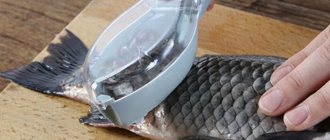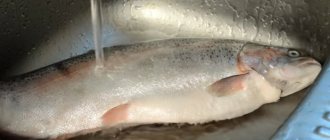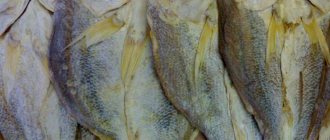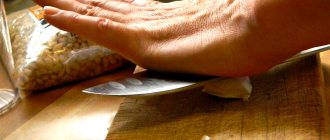To prevent scales from flying
How to properly clean a red or river carcass from the scaly layer so that it does not fly in different directions? It contains a fine structure. And hundreds of scales can be peeled off a fish. You can put it in a plastic bag and remove the scales in it. Manipulations must be careful.
Yandex.Pictures
Cleaning the carcass works well with a regular spoon, which has the thinnest edge on one side. Since it is not pointed, it does not tear off, but touches the scales. They separate from the fish more slowly and because of this they do not fly apart.
Yandex.Pictures
- Fresh or fresh frozen fish;
- a knife or device to remove the scaly layer;
- boiling water and cool water.
How to clean perch, pike and pike perch?
Spiny fish are incredibly difficult to clean. The scales are small, fit tightly to each other and are difficult to tear off. To do this, the fish is scalded or poured with boiling water for 15-30 seconds. It is very important not to overcook, otherwise the skin and top layer of meat will cook. The scales soften and are easily scraped off.
If you don’t want to bother with cleaning at all, you can remove the skin from the fish. The principle is the same as for catfish: cuts around the head and along the ridge, and pull it together with a stocking towards the tail. If you bake a carcass without skin, be sure to coat it with a sauce, for example, mayonnaise with spices, otherwise the meat will turn out dry.
Quick option
- If the carcass is raw, rinse it thoroughly in cold water. First, freshly frozen fish need to be thawed. Less damage to the taste and integrity of the skin of the carcass is caused by too slow defrosting, for example, in the refrigerator. If you don’t have time to wait 6-10 hours, then you can defrost it in ice-cold salted water.
- Transfer the washed carcass to a deep bowl or sink. Heat a couple of liters. water. Gently pour boiling water over it on all sides where there is husk.
- Immediately pour ice water over it or place it on ice so that the fish does not scald in places. After the procedure, a white coating appears on its surface, which can be easily removed with a knife.
- Now you can easily remove the scales by hand. Hook the edge of the scaly layer at the bottom and, moving towards the head, against its growth, completely clean off the scales in a whole layer.
Elimination of specific odor
Even with proper cleaning and complete removal of the skin, catfish meat still has a faint muddy aroma. You can completely get rid of the smell of mud by marinating the fish before preparing dishes from it. For pickling, use lemon juice or dry white wine.
The carcass, cut into pieces, is placed in a suitable container, and the juice from the cut lemon is squeezed onto the meat. You can use orange or lime. If wine is used to prepare the marinade, the pieces are moistened with alcohol. There is no need to pour too much liquid, just drizzle the fillet well. After moistening with marinades, leave the meat for 20-25 minutes. You can rinse it with water before cooking.
To eliminate the muddy taste, fresh milk is also used. It will take a long time to soak the pieces of somyat in it. The process takes at least 3 hours, but after this treatment the meat becomes tender and has a special taste.
To remove the smell of mud, spices are traditionally added when preparing catfish dishes. Black pepper goes best with fish. It is used in ground or whole form. Allspice (Jamaican) pepper, nutmeg, and fenugreek go well with catfish. You can put fresh dill and parsley, bay leaf and onion in your ear.
Gutting
After the scaly layer has been removed, it is necessary to begin removing the insides. Once again, carefully wash the fresh carcass from the whitish coating and you can begin gutting. Here you need to cut out the fins and gills. Make an incision in the belly and remove all the entrails. At this stage, caution is important: the main thing is not to touch the bile. If the gallbladder is damaged, wash the carcass with plenty of salted liquid to get rid of the bitter, unpleasant taste. Then, if necessary, cut off the top and tail.
Yandex.Pictures
Safety precautions when cutting
The common catfish, which is caught in all regions of Russia, has no spines on its body, no sharp plaques or scutes. The main danger is represented by 2 spikes on the front fins (near the head). They need to be cut off immediately, otherwise you can get seriously injured when cleaning the mucus. The rest of the feathers do not have spines.
Filling or skinning is done by holding the knife with the blade away from you and moving it in the same direction. This will avoid accidental injury.
Southeast Asia is rich in different species of catfish (for example, pangasius or channel catfish), which are also sold in Russia. When purchasing such fish uncut or catching it yourself, it is not recommended to use its spine and head for fish soup: the bones of a number of varieties may contain toxic substances.
Using a drill
It is not easy to clean a perch with a knife; this fish has small but strong scales. Fishermen came up with a method that simplified the cleaning procedure. They take a thick board, drive a large nail into it, and put a fish head on it.
Place a metal brush on the drill, run the tool at low speeds and begin to remove the scaly layer with it. It is recommended to hold the lower part with pliers so that the fish does not slide off the board. It is advisable to use this method not in an apartment, but on the street, since the scales will scatter in different directions. To facilitate the cleaning procedure, the carcass should be covered with a damp towel after catching.
Yandex.Pictures
Tools
Some people think that it is quite difficult to free these cold-blooded creatures from their bones, especially the small ones. But it's actually quite simple. Let's practice together, maybe a couple of fish will go away for training, but the third one will most likely be cleaned in an ideal way. But before you cut the fish, you still need to acquire the necessary tools. We will need:
- kitchen scissors for cutting fins;
- knife for removing scales;
- a sharp knife with a thin blade for separating the pulp from the bones;
- long board for cutting carcasses;
- tweezers (but you can do without them);
- and, of course, the fish itself.
With this minimum set you can begin to take action. By the way, regarding the paring knife: the simplest and most popular tool among people is a butter knife (with small teeth) or a vegetable knife (short). You can, undoubtedly, use modern technologies: fish scalers of various types, if you have them. But an ordinary potato knife will be quite enough.
Boiling water
It is quite simple to get rid of the scaly layer using boiling water. This method is suitable for carcasses with hard scales. To do this, you need to pour boiling water over it. Then take the fish out and put it under ice water.
It is necessary to remove the husk starting from the bottom and towards the head, so as not to spoil the skin. The scaly layer of flounder can be pulled together with the skin by making a cut in the lower part and sharply removing the skin.
Don’t forget that you shouldn’t keep the carcass in boiling water for quite a long time, since the husk can come off with the meat.
How to remove mucus from catfish before cooking?
The convenience of the housewife herself during further processing of the fish and the taste of the finished dish depend on the careful implementation of this procedure. Most often, mucus residues give food its characteristic musty taste and smell. The front fins must be removed before cleaning.
The most common method is cleaning with salt. Rub the carcass generously with coarse table salt and rinse with water. Inspect the fish: most often, after the first wash, a little slippery coating remains on the skin, and large quantities of mucus remain at the base of the fins, near the gill covers and under the head. To completely remove it, you need to carefully wipe all such places with salt powder, rinse again and repeat the procedure again, finally removing the mucous layer from the entire surface.
Cooking in the field (for example, on a picnic or fishing) does not require the presence of large amounts of salt. In this case, the fish is rubbed with fresh ash from the fire. It does not contain such large hard particles as salt crystals, so you need to wash the carcass several times. To better cleanse the mucous membrane, it is convenient to remove the ash layer with the blunt side of a knife, the handle of a spoon, etc.
At home and on the go, you can also use the hot cleaning method. Heat the water (or open the tap) and warm the catfish for 1-2 minutes. The water should not boil; a temperature of +50°C is sufficient. The mucus becomes cloudy, milky, and coagulates, losing its slippery qualities. After scalding, it is easy to clean the catfish: the cloudy film is carefully removed with a blunt, hard object.
You can determine the cleanliness of the skin after removing mucus by running the side of a knife across it bluntly. There should be no residue left on it. Clean catfish skin takes on a lighter shade. Once the mucus has been removed, you can begin to cut up the fish.
Using a grater
Processing a carcass that has a hard scaly layer, for example, ruff or perch, must be carried out with a special grater. And also hold the fish by the lower part and perform slow and at the same time strong manipulations. Using a knife, cut a place near the tail section. This option allows you to clean a large carcass. You can even make such a grater yourself at home. Here you will need to nail the tin beer caps to a wooden plank. Process the fish starting from the tail and up to the head. This way the scales will come off without any problems and will hardly fly apart.
You can also make a fish scaler by pinning a piece of tin to a wooden beam, on which you punch holes with a nail. It is possible to construct a grater from a tin can with holes.
How to fillet fish correctly?
Some perceive such manipulations as the highest aerobatics of culinary art, but in fact there is nothing too complicated in the process - you only need a sharp knife and skills that are acquired through experience.
- So, as already mentioned, you need a special curved (fillet) knife. It's the easiest to use. But in extreme cases, a sharp, medium-length kitchen knife with a blade that is not too thick will do.
- Along the spine, we cut the carcass with one longitudinal cut from the head to the back. The blade should go along the bone, and not cut it (this can be felt tactilely), without much tension or effort.
- We begin to cut the fish lengthwise, deepening the cut so that the ribs are also captured. We repeat the same procedure on the other side of the spine, as if highlighting it (the knife works best at an angle of 45 degrees).
- We cut off the edge of the peritoneum along with the hypochondrium bones.
- Carefully probe the resulting fillet. If bones are found, take tweezers and pull them out. After which the fillet can be used for further cooking.
Special knives for cleaning
There are 4 main types of knives. The choice of a particular one depends on the amount of money present and the convenience of the owner. Using them, it is possible to simply and carefully prepare any raw small carcass for cooking.
With a fake edge
On one side of the knife there is a sharp edge, which allows you to quickly remove internal organs from the belly. On the other side there is a special cutting edge for removing the husk. Using it, it is also possible to cut the fish into pieces.
Yandex.Pictures
With serrated sharpening
This is the name of the special teeth located on the edge of the knife. The most common types of sharpening are wave and sawtooth. The uneven size of the teeth allows you to easily clean river and red fish, and their processing capabilities are not impaired due to high-quality sharpening. They also allow you not to put a lot of effort into preparing the underwater inhabitants for cooking. Among the disadvantages, cooks point out that the scales get stuck between the teeth, and also that they cannot be sharpened at home.
With long flexible blade
A cheap and well-known variety, quite convenient. Optimal for slicing baked goods, meat and vegetables, as well as for processing the scaly layer on a carcass. It is advisable to buy a knife with a long and not very thin blade, otherwise the housewife’s hands will quickly get tired. The advantage over other varieties is that it can be sharpened at home.
Yandex.Pictures
With teeth and grooves
A common type since the times of the USSR, which is used by all housewives in the kitchen. Externally, the blade is a metal cutting edge, on the sides of which there are teeth. Cleans off scales without any problems. A thin blade of poor quality will lead to breakage, so you may get hurt.
With container for collecting scales
An unusual method that controls so that the husk does not fly. After cutting, it ends up in a special container, which can be easily and quickly taken and emptied by pouring all the waste into a bucket. Plastic models easily cope with small scales without any problems, but when working with large scales they quickly become unusable.
Konstantin. Chef of the Fish House restaurant chain
I know everything about cooking seafood!
Ask a Question
What is better to clean fish with a spoon or karcher
To reduce the number of scales flying around the kitchen, you can clean the fish with a spoon. The cleaning process is the same as using a knife or grater, but the advantage is that most of the scales remain inside the concave part of the spoon.
We recommend reading:
Sights of Albania
At the same time, it is cleaned quite simply and relatively quickly. For greater convenience in this case, it is better to place the fish on the table and hold it with your hand. By the way, even if it is slippery and heavily covered with mucus, this will hardly interfere with its cleaning using this method, perhaps only slowing down the process a little.
Another unusual method invented by motorists is the use of a Karcher portable car wash. The fact is that water from the hose is supplied under high pressure. If you press the fish to a hard surface, for example, to the ground, and direct a jet at it, the scales themselves will fly out from under its pressure.
But rest assured that you will be guaranteed a fountain of scales mixed with splashes. It may not be possible to completely clean the fish in this way, but most of it can definitely be freed from the outer cover, and the remaining scales can be removed manually. What is better to use in this case? Hard to tell. Everyone chooses a method at their own discretion.
Some people want less dirt, while others want less fiddling with their hands. The final choice of cleaning tool will depend on this.
Author of the publication
offline 3 years
Nika
18
I am interested in hiking and traveling, photography and videography. I have been going hiking since childhood. The whole family went and went - sometimes to the sea, then to the river, to the lake, to the forest. There was a time when we spent a whole month in the forest. We lived in tents and cooked over fires. This is probably why I am still drawn to the forest and, in general, to nature. I travel regularly. About three trips a year for 10-15 days and many 2 and 3 day hikes.
Comments: 0Publications: 668Registration: 10/23/2018
Nika Survival in the wild, Nutrition in the wild, Articles
Instead of an afterword
Over time, any housewife will get used to this or that fish. And if the husband fishes often, then the wife will have to master the recipes for preparing pike perch, crucian carp, pike, and definitely perch and bream. Sooner or later you will understand how to properly clean fish, and fish dishes are much healthier for men than chicken stuffed with antibiotics and containing hormones. Therefore, for men after forty, fish is preferable. And they begin to fish more actively at this time: the children are already grown up, it’s not a good idea to go to parties and get-togethers, so the main male hobby remains - fishing.
Women are also recommended to eat fish to maintain slimness or at least constant weight. In addition, there are many recipes for fish dishes that will decorate any holiday table. After all, a dish with baked sturgeon used to serve as a real decoration for the royal table! Many peoples even have customs associated with fish. For example, on Catholic Christmas it is customary to bake carp with lemon in the belly. Since carp have very large scales, such fish are cleaned from the tail, and then it is customary to carry carp scales in a wallet for the next year so that there is always money.
Who dreams about what?
And finally: do you know what it means if you had to cut fish in a dream, especially live fish? Such a dream is not entirely good, according to many modern and ancient dream books. It can mean an imminent loss of health (by you or loved ones), dissatisfaction with your position and appearance. And if a woman dreams of cutting up fish, then she will not give in to her hobbies and sympathies towards a man. But cleaning fish in a dream means quickly overcoming difficulties, and preparing it means material well-being.
I hate fish to the death of me. Everything about her infuriates me. But the minke whale is normal!
Look at yourself in the mirror and articulately say the following: all these minke whales, squid rings, blue whiting shavings and other garbage are the same disgusting smelling and looking food as whole dry fish, you’re just used to it. They get dirty and smell the same, but, as they say, a little differently. Overcome your prejudices and courageously choose a tailed suicide drinking buddy.
Criteria for choosing fresh chum salmon
You should not purchase the product from street vendors; it is better to give preference to supermarkets or stores selling fish and seafood. There, storage rules are observed, all necessary documents are available, and a receipt is issued, which serves as a guarantee of the quality of chum salmon.
You need to inspect the chilled fish, press your finger on the carcass in the abdomen area - it should be elastic and immediately straighten. Bright red or pink gills and clear eyes with a clearly visible pupil indicate the freshness of chum salmon. When cutting, the meat of a high-quality carcass will be dense, with whole fibers.
Signs of poor quality fish:
- dry, brittle scales;
- excess mucus;
- soft, inelastic belly with greenish spots;
- gray, darkened gills;
- unpleasant odor;
- shrunken, sunken, cloudy eyes.
Useful properties of chum salmon
100 g of fish pulp contains about 127 kcal, 24 g of proteins and 10 g of fat.
The chemical composition of chum salmon contains vitamins A, E, C, PP, D, group B, and polyunsaturated omega fatty acids. When a person regularly consumes tasty and healthy dishes, his body is saturated with minerals: calcium, potassium, phosphorus, magnesium, sulfur, fluorine, sodium, manganese, iron, iodine, zinc, selenium, copper, molybdenum. This improves the condition of the heart and blood vessels, bone and muscle tissue, and reduces the risk of strokes, heart attacks, and atherosclerosis. Doctors, nutritionists, and scientists recommend introducing fish into your diet at least twice a week. Return to list
Do I have to go to the kiosk for a newspaper now?
This is a personal matter for everyone, but, of course, it is better to cover the table with something that can later be collected in a heap and thrown out in one fell swoop. It will be a newspaper or a shoebox - it doesn’t matter. The scales will fly in all directions, so prepare either a normal springboard or a vacuum cleaner.











